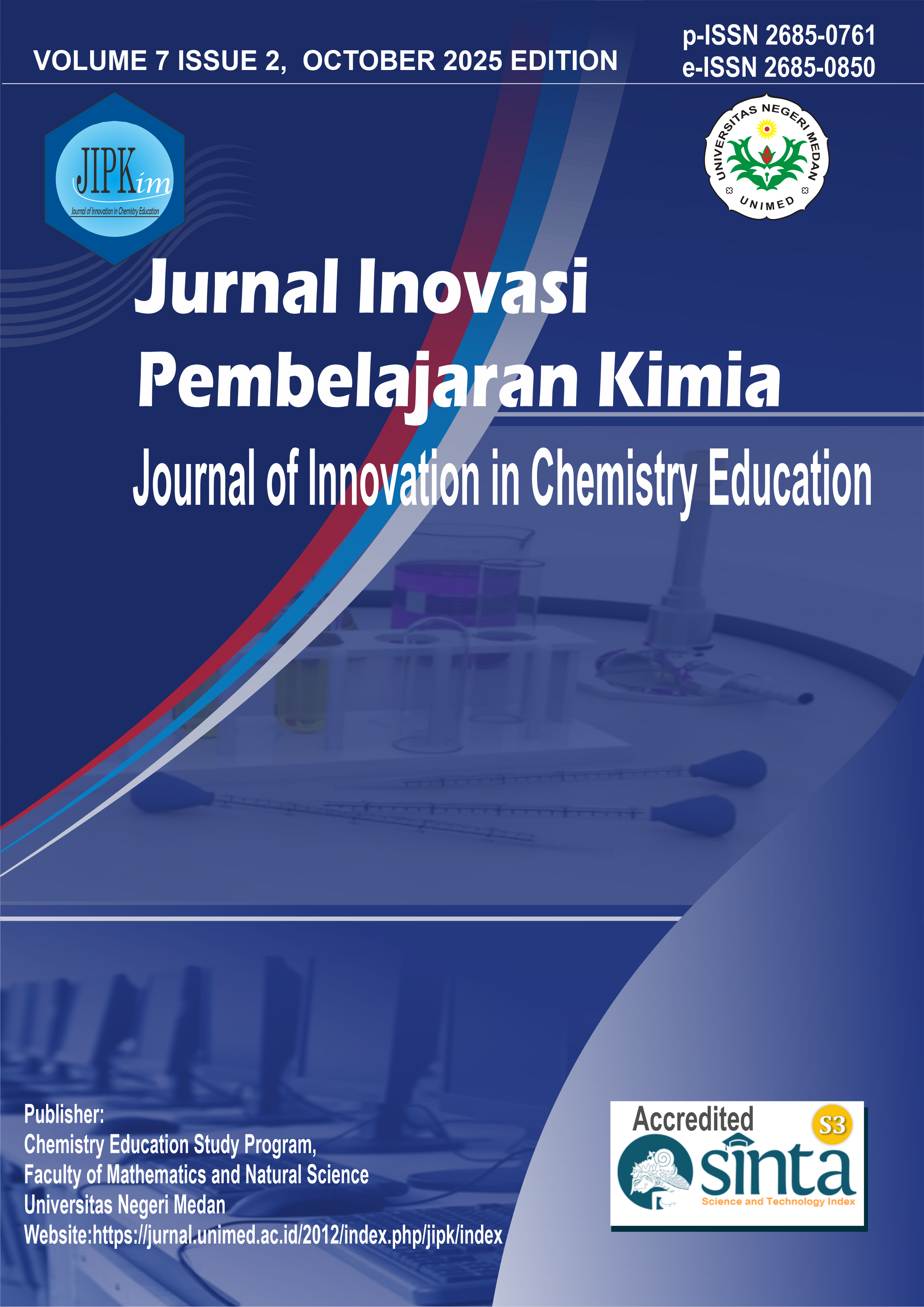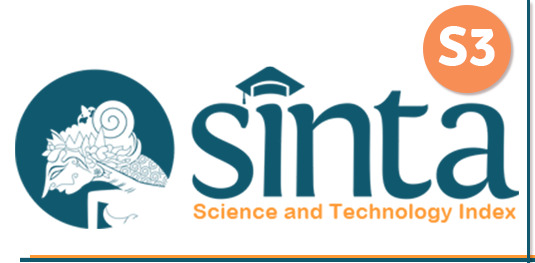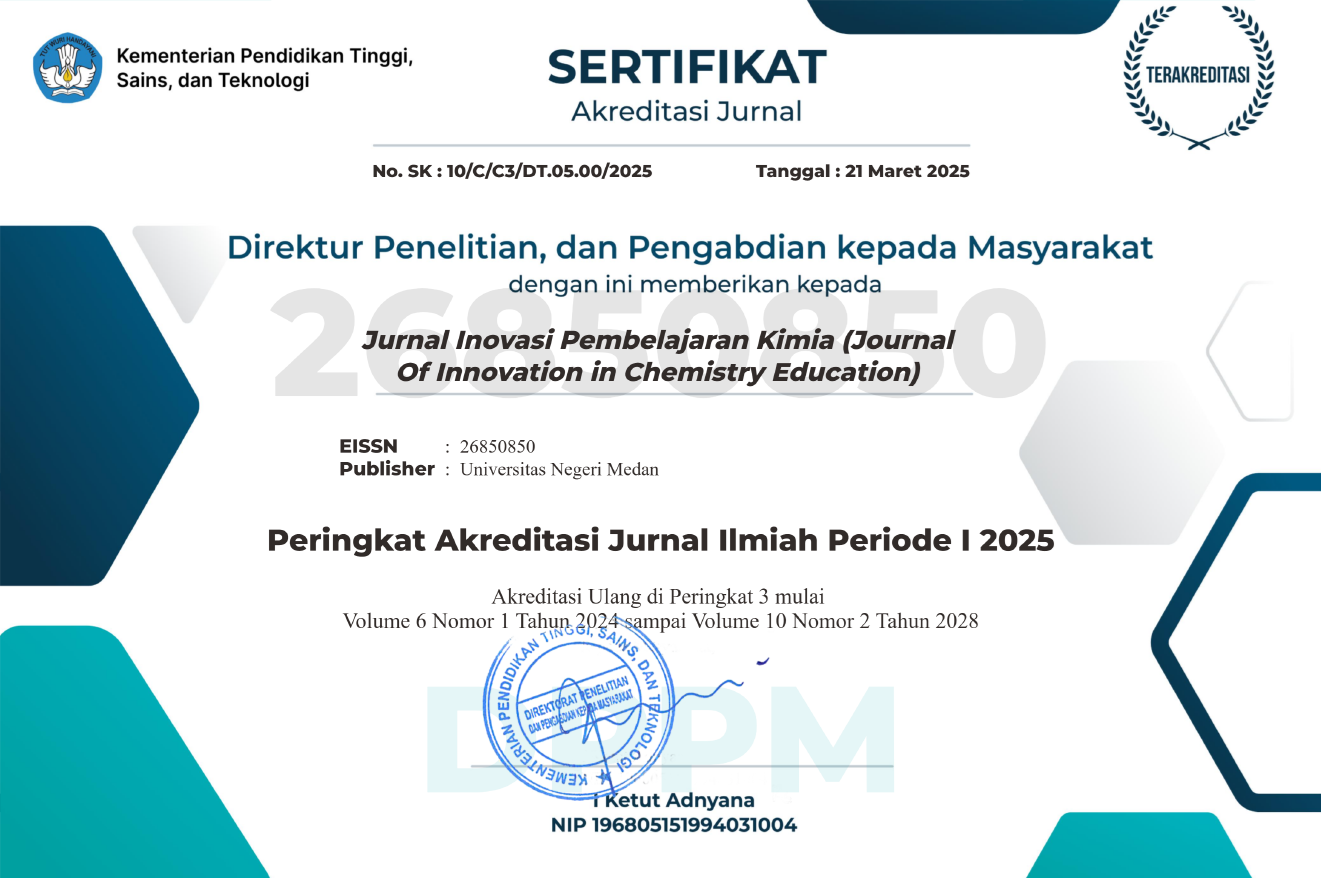The Influence of the Discovery Learning Model Assisted by Kahoot Media on Learning Outcomes
Keywords:
discovery learning, kahoot, learning activities, learning outcomes, atomic atructureAbstract
This study examined the effect of the Discovery Learning model assisted by Kahoot media on students' activities and learning outcomes on the topic of atomic structure. This study involved students of class X IPA SMA IT Jabal Noor Medan, with purposive sampling selecting class X PSP B as the experimental class (Discovery Learning with Kahoot) and class X PSP A as the control class (conventional learning). The test and non-test instruments used were valid, and the data met the assumptions of normality and homogeneity. The results showed that the experimental class achieved a higher average activity score (87.6) than the control class (76), with a significant difference (t count = 6.305 > t table = 2.023). The N-Gain score of the experimental class (0.83) also exceeded the N-Gain score of the control class (0.75). These findings indicate that the Discovery Learning model assisted by Kahoot is effective in increasing students' activities and learning outcomes in studying atomic structure.References
Aibar-Almazán, A., Castellote-Caballero, Y., Carcelén-Fraile, M., Rivas-Campo, J., & González-Martín, F. (2024). Kahoot! as a tool for university teaching innovation: Effects on attention, creativity, self-regulated learning and problem-solving. Frontiers in Psychology. https://doi.org/10.3389/fpsyg.2024.1370084
Al-Flayeh, I. S., Keziah, C. B., & Dikenwosi, R. (2025). Game on for chemistry: How Kahoot transforms learning outcomes and student interest. Journal of Chemical Learning Innovation, 2(1), 1–11. https://doi.org/10.37251/jocli.v2i1.1717
Aliyu, H., Abdul Talib, C., & Abubakar Garba, A. (2022). Use of Kahoot! for assessment in chemistry classroom: An action research. International Journal of Current Educational Studies, 1(2), 51–62. https://doi.org/10.46328/ijces.22
Aryanthi, K. D., Suwatra, I. I. W., & Suarjana, I. M. (2019). Pengaruh Model Pembelajaran Air Berbantuan Media Gambar Terhadap Hasil Belajar Ips Siswa. Media Komunikasi FPIPS, 17(1), 33–43. https://doi.org/10.23887/mkfis.v17i1.22215
Astafani, A., Resmawati, R. F., & Hakim, M. E. L. (2024). Systematic Review : Faktor- Faktor Kesulitan Belajar Materi Kimia. Jurnal Inovasi Pendidikan Kimia, 18(2), 82–88.
Astafani, R. D., Rahmawati, Y., & Ardiansyah, R. (2024). The implementation of discovery learning model to improve students’ learning outcomes in reaction rate material. Jurnal Inovasi Pembelajaran Kimia (JIPK), 8(2), 112–121. https://doi.org/10.24114/jipk.v8i2.42789
Fitria, N., & Santosa, H. (2023). Enhancing student engagement and learning activities through digital game-based learning in chemistry class. International Journal of Interactive Mobile Technologies, 17(4), 32–45. https://doi.org/10.3991/ijim.v17i04.37125
Fitriana, N. (2023). Peningkatan Keaktifan Peserta Didik Melalui Media Persentasi Classpoint Dan Game Edukasi (Quizizz & Kahoot) Pada Pembelajaran Kimia. ACTION : Jurnal Inovasi Penelitian Tindakan Kelas Dan Sekolah, 3(1), 35–41. https://doi.org/10.51878/action.v3i1.1982
Hidayah, S., & Maulana, I. (2020). The effect of discovery learning with virtual lab integration on students’ activity and learning achievement. Jurnal Inovasi Pembelajaran Kimia (JIPK), 4(1), 78–86. https://doi.org/10.24114/jipk.v4i1.34723
Jayadiningrat, M. G., Agus, K., Putra, A., Septian, P., Adistha, E., Ganesha, U. P., Belajar, A., & Belajar, H. (2019). Penerapan Model Pembelajaran Discovery Learning Untuk Meningkatkan Aktivitas Dan Hasil Belajar. Jurnal Pendidikan Kimia Undiksha, 3(2), 83–89.
Konengian, N. Y., Fahyuddin, & Marhadi, M. A. (2023). Penerapan Media Kahoot Pada Materi Stoikiometri untuk Meningkatkan Hasil Belajar Kognitif Siswa Kelas X. Jurnal Pendidikan Kimia, 8(3), 242–255.
Laode, A., Dahlan, & Musta, R. (2024). Efektivitas Model Pembelajaran Discovery Learning dalam Meningkatkan Hasil Belajar Siswa pada Materi Struktur Atom. Sains: Jurnal Kimia Dan Pendidikan Kimia, 12(2), 139–143. https://doi.org/10.36709/sains.v12i2.45
Lestari, M. D., & Saputra, H. (2021). Discovery learning-based chemistry instruction to enhance student motivation and activity. Jurnal Inovasi Pembelajaran Kimia (JIPK), 5(2), 134–142. https://doi.org/10.24114/jipk.v5i2.36945
Nurwahidah., Danial, M., & . M. (2018). Pengembangan Perangkat Pembelajaran Kimia Berbasis Discovery Learning Pada Materi Larutan Penyangga Di Kelas Xi Sma. Chemistry Education Review (CER), c, 42. https://doi.org/10.26858/cer.v0i0.7517
Penerapan, P., Pembelajaran, M., Terhadap, L., Aktivitas, P., Didik, P., Pembelajaran, D., Materi, K., Karbon, S., Rukayah, S., & Melina, I. (2019). Pengaruh Penerapan Model Pembelajaran Discovery Learning Terhadap Peningkatan Aktivitas Peserta Didik Dalam Pembelajaran Kimia Materi Senyawa Karbon Di Kelas Xii Ia-5 Sma Negeri 4 Banda Aceh. Jurnal Pencerahan, 13(1), 33–48.
Putri, K. A., & Suryani, D. (2023). The effect of discovery learning model assisted by interactive media on students’ chemistry learning outcomes. Jurnal Inovasi Pembelajaran Kimia (JIPK), 7(3), 156–165. https://doi.org/10.24114/jipk.v7i3.41957
Putri, R. H., Lesmono, A. D., & Aristya, P. D. (2024). Pengaruh Model Discovery Learning Terhadap Hasil Belajar Siswa Pada Materi Struktur Atom. Jurnal Inovasi Matematika (Inomatika), 1(1), 31–37.
Rahmadani, A., & Nurhayati, R. (2022). Improving student engagement through discovery learning model on atomic structure topic. Jurnal Inovasi Pembelajaran Kimia (JIPK), 6(4), 210–219. https://doi.org/10.24114/jipk.v6i4.39864
Yılmaz, S. S., & Yaşar, M. D. (2023). Effects of Web 2.0 tools (Kahoot, Quizlet, Google Form example) on formative assessment in online chemistry courses. Journal of Science Learning, 6(3), 145–156. https://doi.org/10.xxxx/jslearning.v6i3.203
Zainuddin, Z., & Chu, S. K. W. (2022). Learner engagement in flipped and gamified learning environments: A comparative study. Computers & Education, 185, 104531. https://doi.org/10.1016/j.compedu.2022.104531













